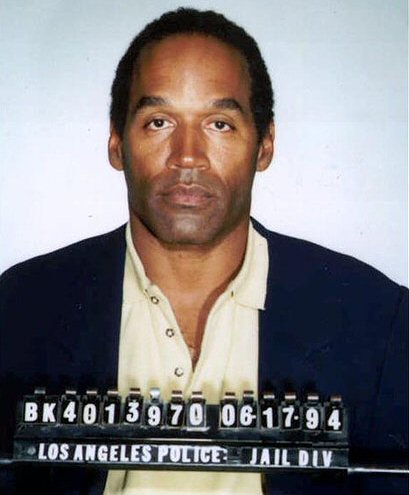 Image from: http://wolfsbayne.files.wordpress.com/2008/04/oj-simpson.jpg
Image from: http://wolfsbayne.files.wordpress.com/2008/04/oj-simpson.jpgIn the book, Gender Race and Class in Media, a Text Reader, written by Gail Dines and Jean M. Humez, the chapter titled, The Greatest Story Ever Sold, Marketing and the O.J. Simpson Trial, written by George Lipsitz really does not really mention race as a factor in the popularity of marketing the O.J. Simpson Trial. Even so, the O.J. Simpson Trial became an extremely popular story and marketing product within many different modes of media. Lipsitz writes that the trial’s story gained popularity and sold well because the O.J. trial contained the necessary elements that have to do with the main themes that “…organize television discourse in the United States” (179). Those main themes are, “…the primacy of products as the center of social life, the stimulation and management of appetites, and alarm about the family in jeopardy” (179). LIpsitz writes on page 179 that “A story linking any of these two categories will always make the news…the O.J. Simpson trial…contained all these elements necessary to televisual representation: it was a story about products, appetites, and the family in jeopardy”.
O.J’s role as an athlete, actor, and celebrity also enhanced the marketing of his trial. Lipsitz writes that O.J.”s trial could have come out of several murder television shows, celebrity shows, and shows about the courtroom. Lipsitz writes that the trial was able to “…bring together the various apparatuses of advertising, publicity, spectator sports, motion pictures, television, and marketing into a unified totality generating money0making opportunities at every turn” (178). Not only was the main character in the trial, O.J., used for marketing purposes, but individuals directly and indirectly involved in the trial were also used. One example includes defense witness Brian “Kato” Kaelin receiving his own talk show from a Los Angeles radio station. Jurors wrote books about the trial and the judge was even offered a $1 million role in a television program (178).
The only part in which Lipsitz refers to the African American community and the trial’s effects on that community is when Lipsitz writes about the trial’s popularity within televised news networks. Among CNN, Court TV, Entertainment Tonight, and other shows, BET also witnessed a rise in viewers throughout O.J.’s trial. This was largely due to the fact that BET conducted a live interview with O.J. Simpson. However, Lipsitz suggests that Simpson’s involvement in “diverse areas of entertainment gave him the kind of visibility that television loves to recycle and repackage” (177). Thus, the O.J. Simpson trial was able to be marketed across many different areas of media; cable and broadcast television networks, newspapers, magazines, literature, videotapes, etc.
In Bias Test, Shades of Gray- New York Times
http://www.nytimes.com/2008/11/18/science/18tier.html?_r=1&8dpc
Although this article has little to do with representations of racial-minorities in the news, I found it quite interesting. In an article written on November 17, 2008 in the New York Times titled In Bias Test, Shades of Gray, computer testing intended to reveal unconscious racial bias was addressed. In this article, the author writes that tests to uncover unconscious biases towards African American people are not as legitimate as they once were thought to be. The author writes, “The test is widely used in research, and some critics acknowledge that it’s a useful tool for detecting unconscious attitudes and studying cognitive processes. But they say it’s misleading for researchers to give individuals ratings like “slight,” “moderate” or “strong” — and advice on dealing with their bias — when there isn’t even that much consistency in the same person’s scores if the test is taken again” (NYTimes). A psychologist at Texas A&M interviewed for the article suggested that the test itself is biased and too controlled by a small amount of people. The psychologist basically wrote off the test as inaccurate and useless.
I find it interesting that one of the main stories on the New York Time’s website is an article writing off the validity of a computerized bias test. I felt that the article was telling me that bias tests are illegitimate and should not be considered factual. Although I don’t necessarily feel as if the article was completely supporting the idea that most Americans are not racially biased, I felt that because the article was trying almost to disprove the validity of the test, the article was also saying that most Americans today are not racially biased. I’m not completely sure that I agree with this article, however, I am also not sure that I agree that bias tests are entirely valid.

1 comment:
Yeah, I've had my questions about those computer-based bias tests, too. I've taken a couple, usually when I teach this class, but I'm not sure how much help they are.
Post a Comment